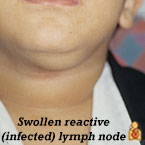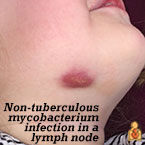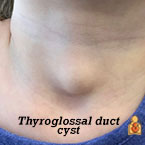Knot on Back Left of Neck 12 Years
By: John E. McClay, MD, FAAP
Finding a lump on your child's neck can be alarming but neck masses are very common in children and usually harmless.
A swollen spot on the neck is often an enlarged lymph node, for example, a sign your child's immune system is fighting off an infection.
Always have any lumps, bumps or swelling on your child's neck checked.
Your child's pediatrician will check to see the lump's size, location, firmness, and ask you about:
- the legnth of time it has been there
- whether your child has been sick or has other symptoms of infection
- whether your child has been near pets or other animals, or has been outside the country
Most lumps found in a child's neck are enlarged lymph nodes caused by an infection.
 Lymph nodes are part of the immune system and help rid the body of harmful bacteria, viruses, and other causes of irritation or infection. There are 200 to 300 lymph nodes in the back of the nose, throat, and neck. They may swell when you child's body is fighting a common cold or strep throat, for example.
Lymph nodes are part of the immune system and help rid the body of harmful bacteria, viruses, and other causes of irritation or infection. There are 200 to 300 lymph nodes in the back of the nose, throat, and neck. They may swell when you child's body is fighting a common cold or strep throat, for example.
Lumps on the neck may also be an infection of the lymph node itself, or in other nearby spots.
Diagnosis and treatment of infections of the neck:
 The most common infections of the neck are viral or bacterial and some can be treated with antibiotics. In certain types of "atypical" or unusual neck infections, a child may not seem that sick but the infected lumps seem to worsen. They may also be changes in the color and consistency of the overlying skin.
The most common infections of the neck are viral or bacterial and some can be treated with antibiotics. In certain types of "atypical" or unusual neck infections, a child may not seem that sick but the infected lumps seem to worsen. They may also be changes in the color and consistency of the overlying skin.
The most common type of atypical lymph node infection is non-tuberculosis mycobacterium and may need surgery, or take months to improve.
If your child does not respond to antibiotics or seems especially sick, has a high or prolonged fever and redness of the skin over the lump, your pediatrician may recommend:
-
IV antibiotics, which treat infections more quickly because they go directly into the bloodstream. A visit to the emergency department or stay in the hospital will also make it easier to monitor your child.
-
Lab or imaging tests, often either ultrasound or computer tomography (CT scan), to determine how severe the infection is. In rare cases, a needle biopsy might also be done to help identify the cause of the infection.
-
Surgical draining. If antibiotics alone do not clear up the infection, sometimes it may need to be drained using a needle or surgical instruments such as a scalpel or lancet.
Not all neck lumps are related to an infection.
The lump could be from different types of cysts, abnormal growths of blood vessels, scar tissue or--rarely--tumors or cancer. Location, consistency, and color of the lump or skin around it can give clues as to what it might be.
Congenital cysts
It is common for young children to have small neck cysts—benign (non-cancerous) pockets of tissue that formed before birth and can grow larger over time. These are called congenital cysts. They can cause repeated infections and may need to be removed surgically.
Common types of congenital cysts:
-

Thyroglossal duct cysts are the most common type of congenital neck cyst. They are usually located in the front of the neck, formed from cells leftover after the thyroid gland develops in the womb.
-
Branchial cleft cysts form when sections of the head and neck don't come together exactly right before birth. They often are located below one or both ears or in the sides of the neck. These cysts may not be noticeable until later in childhood or adolescence.
-
Dermoid cysts can happen when layers of skin do not form properly during fetal development. These slow growing cysts may contain trapped sweat glands, hair follicles and other types of cells normally found in skin.
Deep hemangiomas
Sometimes neck lumps are a type of birthmark called hemangiomas, growth of blood vessels under a child's skin. They may be noticeable when a baby is born and enlarge quickly by the first birthday. Deep hemangiomas can feel squishy than cysts, and the skin over them may look reddish. Although they often go away by the time a child reaches school age, your pediatrician may recommend treatment if it starts to cause grow rapidly or cause other symptoms.
Torticollis "pseudotumor"
Some babies with torticollis, a tightness on one side of the neck, develop a pseudotumor on the large muscle that connects the head, neck, and breastbone. The bump is often made up of scar tissue where the muscle was injured in the womb or during birth. It usually becomes noticeable between birth and 8 weeks of age. Your pediatrician may provide a referral for physical therapy that includes gentle heat, massage and passive stretching.
Malignant masses
Rarely, a neck lump may be a sign of childhood cancer. The most common types of childhood cancers of the neck include lymphoma, neuroblastoma, sarcoma, or thyroid tumors. A needle biopsy can help with the diagnosis, or the lump may need to be surgically removed to exam the cells under a microscope.
For more information, watch this video from the American Society of Pediatric Otolaryngology:
Remember
Talk with your pediatrician if you notice a lump on your child's neck. Identifying the cause of the lump will help determine the best decisions about treatment, if any is needed.
Additional Information
- What is a Pediatric Otolaryngologist?
- When is a Sore Throat a More Serious Infection?
- Baby Birthmarks & Rashes
About Dr. McClay

John E. McClay, MD, FAAP, is a fellowship trained pediatric otolaryngologist–ear nose and throat surgeon–who has taken care of children for more than two decades. Dr. McClay has authored over 30 professional articles in peer reviewed medical journals describing his research studies. He was an academic professor in the Department of Otolaryngology/Head and Neck Surgery at the University of Texas at Southwestern Medical School in Dallas for 17 years, where he had an academic Professorship in his honor. He has now been in private practice for more than 6 years. He has been named one of D Magazine's Best Pediatric Specialists every year since its inception in 2003, and one of the best pediatric specialists in the state of Texas by Texas Monthly for the last 13 consecutive years. Within the American Academy of Pediatrics, he is the Education Committee Chair for the Executive Committee of Otolaryngology.
The information contained on this Web site should not be used as a substitute for the medical care and advice of your pediatrician. There may be variations in treatment that your pediatrician may recommend based on individual facts and circumstances.
Knot on Back Left of Neck 12 Years
Source: https://www.healthychildren.org/English/health-issues/conditions/ear-nose-throat/Pages/What-to-Do-If-You-Discover-a-Lump-on-Your-Childs-Neck.aspx
0 Response to "Knot on Back Left of Neck 12 Years"
Post a Comment